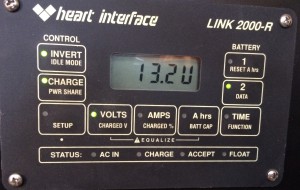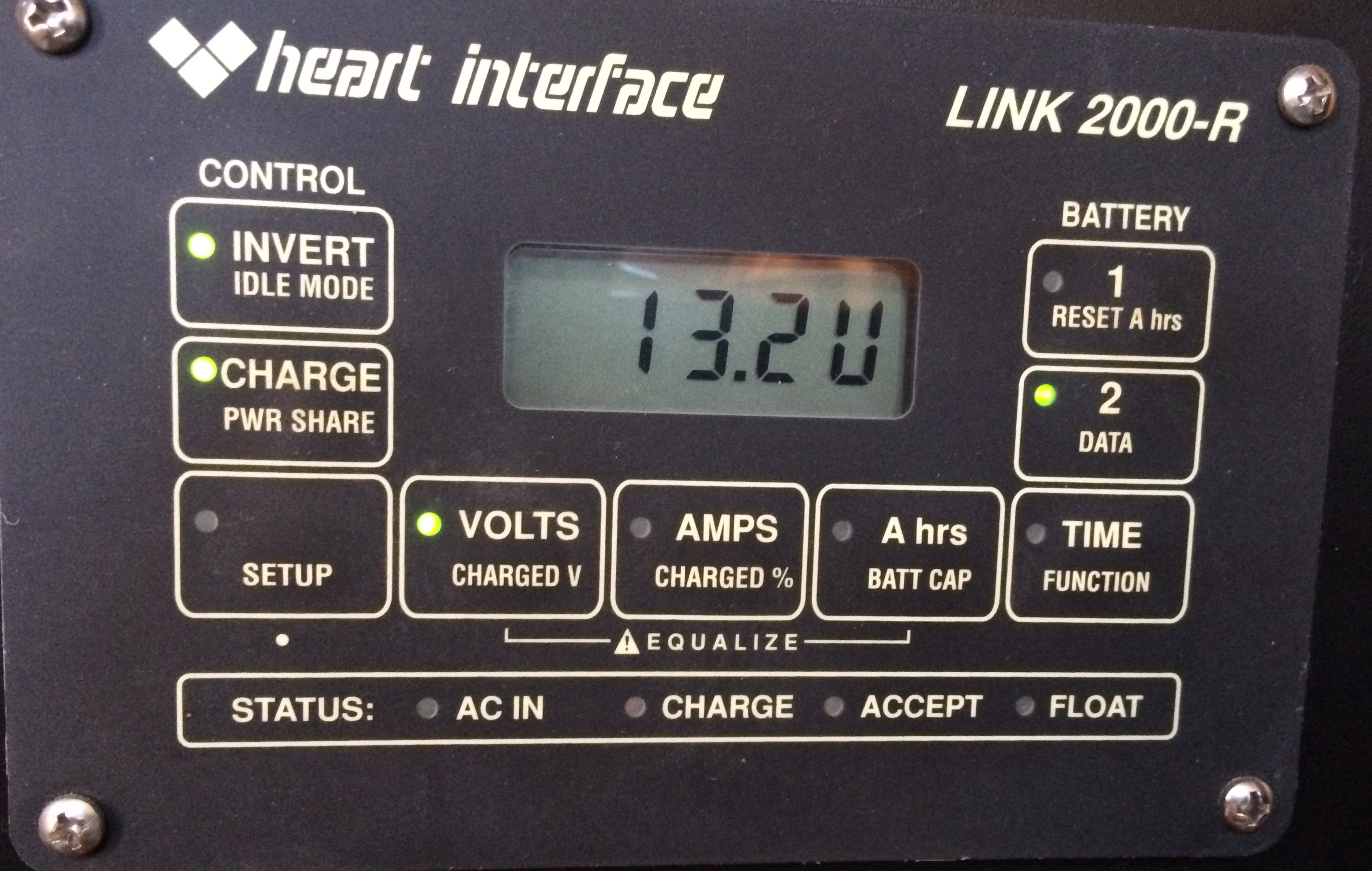One of the more complex and, to me, challenging aspects of living on a boat is energy management. I’ve lived with the luxury of readily available electricity far more than without it. My experience has been pretty much black and white: full and reliable access to power, or none at all. I’ve gone days and weeks off the grid while hiking, riding horse or paddling canoes in remote wilderness areas, such as in the Boundary Waters in Minnesota, the Alaska Range and the Queensland Outback in Australia. I also lived without electricity in West Africa as a Peace Corps volunteer. You have to adjust to it and rely on other sources of light and energy: wood fires, gas stoves and lanterns and batteries.
Sailing is the one grey patch in the black and white milieu. Chartering and cruising experiences usually lasted a week or so at a time with plenty of dockside energy fixes between anchorages and mooring balls. Even the overnights and longer trips on the Blue Loon, our Rhodes 22, presented uncomplicated energy management to power essential navigation and anchor lights, a laptop and mobile phones. And fire up the outboard. Our two batteries were charged whenever the four-stroke Yamahammer sipped gas or the sun stirred the little sailboat’s solar panels from their languid reveries.
Complexities
Gaviidae is loaded with appliances and high tech devices powered by the boat’s bank of house batteries and a separate starting battery bank. These are charged by the boat’s own power plant—the alternator on the diesel engine– when not suckling from the electric grid. Thrown into the mix are a sophisticated and—to me—mysterious charging management system that includes a battery monitor and a large inverter/charger that hums mirthlessly and tunelessly and lurks menacingly beneath the navigation station. This is a whole new experience fraught with new and potentially expensive complications.
An alternator governed by an external regulator—both of which are steered by the neglected and seemingly resentful digital monitor–can starve batteries and shower havoc and distress on technojunkies and –phobes alike. Our LINK 2000-R digital energy meter/control device is eerily similar to, if not as complex as, the malignant computer HAL in Stanley Kubrick’s movie 2001: A Space Odyssey. We call our device Link. It is vintage 1999, built just a couple of years before the unleashing of Kubrick’s fictional HAL.

Our little electrical hell began after anchoring at Croker Island for several days with our friends Jerry & Clare, who sailed and motored several days against Aeolian westerlies from Georgian Bay to rendezvous with us. Leaving Croker on a calm morning, we followed them on their boat, Magic Carpet, thru the perilous rock-strewn shortcut in the Benjamin Islands to an idyllic bay on Hotham Island. (Are you beginning to get the Homeric theme at play here? Doh! Not Homer Simpson. )
Hotham was just a couple hours by motor. Shortly after we anchored, Elaine, who has a home on this bay with her husband, Norm, paddled by in her kayak to invite us to happy hour. This is a ritual for boaters who drop anchor in this particular bay—a tradition started by the cabin’s previous owner, Ray. Jerry and Claire have frequented this bay since before Ray built his cabin with Norm’s help. They have become friends with Elaine and her husband, Norm.
While completing our boat log on arrival, I saw that the house batteries were seriously low, according to Link. We restarted the engine and discovered that the tachometer was not registering—a chronic occurrence since we changed batteries back in Houghton, MI. In addition, Link and our redundant analog meters were not registering enough voltage to charge the batteries. Revving the engine neither moved the tach and analog needles nor impressed Link.
I pulled a voltage meter from our electrical tools and supplies box, opened the engine compartment and got an equally low reading directly from the alternator. I knew the alternator’s two belts were tight, so I suspected a problem with either the alternator itself, or the external regulator. This regulator had replaced another faulty regulator two years ago.
Can’t Miss Happy Hour
By this time, it was 5:00—Happy Hour at Elaine and Norm’s was underway. We shut things down, lowered the dinghy and reluctantly motored to the party. Julie and I were the last to arrive. A dozen or so people were gathered on the cabin’s deck: our hosts and boaters from the 7 or 8 other boats anchored in the bay. Discussion soon turned our charging issues. Norm, Jerry and a couple other seasoned boaters speculated about faulty alternator diodes or thyroids or something and urged us to get to a marina ASAP to recharge the batteries and get a technician on board before we lost perishable food and damaged the batteries. These were the batteries we just bought a few weeks prior in Houghton, MI. Julie and I hastily returned to Gaviidae, hoisted the dinghy, weighed anchor and headed to Spanish, a small town with a marina some 10 miles to the west. Sadly, we had to leave our friends on Magic Carpet behind.
We arrived at the marina shortly before the office closed for the night, got connected to shore power and hauled out the books and manuals we have on boat electrical systems.
Saturday morning we reached out to Mike Gozzard, who had helped us with charging issues before. Mike is usually at the boatyard Saturday mornings and we were hopeful that we might catch him. Meanwhile I pored over the boat manuals looking for clues among the runes and gibberish between the covers of owner’s manuals and highly recommended DIY boat books . Prior efforts to probe the enigmas of electrical management on boats had not been particularly productive. The books are full of mystical mathematical incantations and sinister alchemies. Just mentioning electrical management on boats would short my cranial synapses; trying to read about it quickly induced coma. But I dug back in, and also began trying to make sense of the owners’ manuals for Link and his progeny, the Link regulator. Did I mention that the external regulator was a Link?
The Spanish marina was stiflingly hot Saturday and Sunday. The marina’s wi-fi system was inadequate and unreliable. And Mike was not getting back to us – I suppose he is entitled to a weekend. Fortunately, the Marine Air Systems air conditioning on the boat works splendidly when tethered to the Grid, mainlining electricity like an energy junkie. Its control panel is clean and simple. The faceplate features a penguin and a stylized “AIRRRRRRR” graphic. Friendly. Benign. Easy to understand and use. Unlike Link with its impassive liquid crystal screen and baleful pinpoint LEDs and the menacing double-belted alternator.
Mike responded Monday morning. He had been at the Canadian National Melges 24 regatta where Team Gozzard did quite well. He was jubilant, back at work and ready to help us with our charging issues. Over the phone and via text and email, Mike guided us thru a series of generator, regulator and battery isolation tests over the next two days. Got to hot wire and excite the generator; reminded me of Frank Zappa’s ballad Dynamo Hum: “I poked and stroked ‘til my wrists got numb/But I still couldn’t make that dynamo hum.”
The alternator was fine—no thyroid issues. The regulator seemed to be doing its job. The batteries were all up to snuff. We discovered that a switch for the engine battery, which is supposed to be isolated, was actually connected to the house bank. That was not good, but it did not explain the erratic and subpar charging issues.
We were about to begin another round of tests when I reminded him that we had had similar issues when we first got the boat. Those issues were fixed when our friends Tom and Rose McMaster programmed Link. It was an Ah-ha! moment for Mike. He asked if we reprogrammed the monitor after installing the new batteries earlier in the month. Not only had we not reprogrammed Link then, we did not know we needed to reprogram the evil little bastard every time batteries are disconnected. Like over the winter! Or when they’re replaced. Or even when the terminals need cleaning and scraping. Link resets itself to default mode when the batteries are reconnected. We thought it was smart enough to know what it was hooked up to. But no, it had to be told about the batteries and reminded about the alternator and all the details about appliances and devices used onboard had to be factored in to make it perform right.
I was giving HAL, I mean Link, too much credit for its sophistication. It has to be reeducated every time it wakes up from hibernation or any other scenario in which it is not getting power.
Lightbulb Moment
Then it struck me: Julie and I go thru the same thing every spring. After we’ve been off the boat for a few months, we have to relearn everything from basic knots and points of sail to…..reprogramming LINK.
The hieroglyphs in the owner’s manual started to make sense. I began to grasp the limits of Link’s all-knowing, all-seeing ways. With the song “Daisy” playing in my head, I punched in some numbers from the battery and generator documents. I calculated and fed Link some power consumption numbers. He’s all happy now. His unblinking LEDs seem a little friendlier. The batteries are stronger and recover nicely if they haven’t been recharged by shore power or the alternator. The tachometer and analog dials carefully and consistently do their jobs.
For all the newfound synchronicity in Gaviidae’s charging system and my minor breakthroughs in electrical science, I am aware that Link is long since outmoded and likely to be replaced with a cheerier, more user-friendly, state-of-the-art battery monitor and consigned to some dustbin of archaic technology. I wonder if I will find myself wax nostalgic and missing Link?
Nah.
July 24-27, 2015 46° 11.016’N 82° 21.690’W 535.4 Nautical Miles
